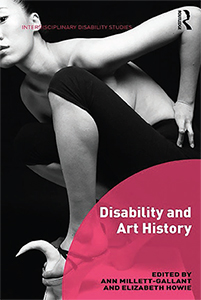At the Intersection of Art and Disabilities

Timothy Hiles, associate professor of art history, joined the faculty of the School of Art in 1991 and for the last two decades has taught a popular course on the history of photography. Over the years, his research interests have also turned in this direction, most recently to the intersection between disability studies and art history.
Hiles will present a paper during the 2018 College Art Association (CAA) conference in Los Angeles titled “Challenging the ‘Normal’: Expanding Human Perception in the work of Sue Austin and Alice Sheppard” that explores works created by two artists with disabilities. Sue Austin is a multimedia performance and installation artist who perhaps most famously conveys the freedom provided by her wheelchair through graceful underwater routines. Alice Sheppard, formerly a Medieval Studies professor, became a dancer and choreographer who uses movement to explore the “societal and cultural significance of difference,” according to Sheppard’s website. Hiles will examine how the works of these two artists can be understood within the categories of “Movement,” “Performance,” “Beauty,” and “Diversity.”
“It will fall to artists once again to question social constructs and belie the illusion of a monolithic society,” Hiles says.
Previously, Hiles has worked on images of the disabled in post-World War II photography. He delivered a presentation on photographs of the disabled during the Civil Rights era at the 2013 meeting of SECAC (formerly the Southeast College Art Conference), which was well received and led Hiles to explore this topic further. In July 2017, he gave a paper on “Disability, Perception, and Postmodern Photography” at the 17th International Conference on Diversity in Organizations, Communities, and Nations in Toronto. Later published in Review of Disability Studies, this article explored how the act of staring was used in photographs of persons with disabilities by Gary Winogrand and others to challenge the idea of what was considered “normal” at the time.

Hiles continued this line of research culminating in another essay, “Representing Disability in Post-World War II Photography,” published in 2017 in the book Disability and Art History, edited by Ann Millett-Gallant and Elizabeth Howie. He explores the topic in a thematic fashion, focusing on three different types of visual language used in photographs of the disabled:
- Isolating the ‘other’ through visual structure.
- Visual language: integrating the ‘other’ and the open form.
- Expanding the normal: deconstructing the ‘other’ and the provocateur.
Hiles explains that through these devices the notion of what is normal was continually challenged.
Disability Studies is a fairly new field of study, originating in the 1980s, and although persons with disabilities have always been depicted in art, it is only recently that art historians have focused explicitly on such images. According to the authors of Disability and Art History, it is the first book of its kind to feature interdisciplinary art history and disability studies scholarship.
Hiles is planning a future book project that will encompass both aspects of his research—works depicting the disabled and work by disabled artists—but in a thematic manner based on the categories he is exploring in his upcoming CAA paper. This study should make important contributions to this relatively new field of study.